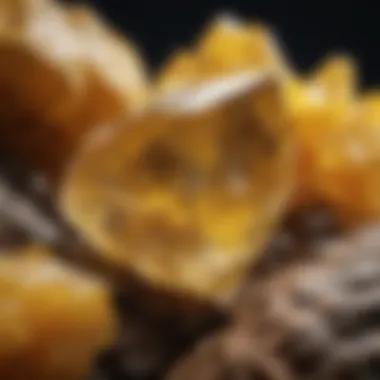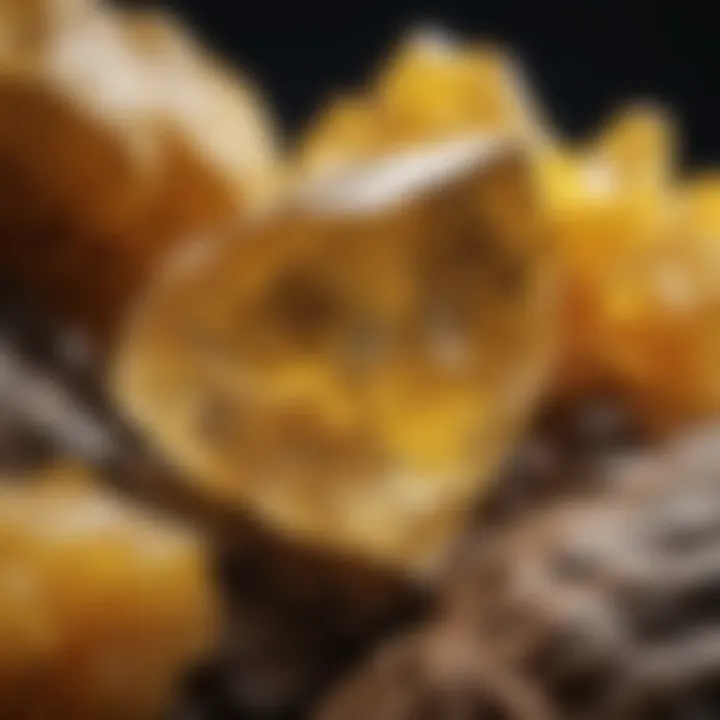Explore the Beauty and Science of Yellow Rocks


Intro
Yellow rocks and minerals hold a unique allure in the realm of geology and mineralogy. Their vibrant hues range from soft pale yellows to deep, rich golds, capturing the attention of enthusiasts and collectors alike. Understanding these geological specimens requires delving into their formation processes, properties, and broader implications within both scientific and cultural contexts.
This article aims to provide a comprehensive exploration of yellow rocks and minerals, revealing their significance and applications.
Featured Collectible of the Month
Overview
Each month, we highlight a specific yellow mineral of interest—this month, we focus on citrine. Citrine, a transparent yellow variety of quartz, has fascinated collectors with its beauty and purported metaphysical properties. Known for its energy and creativity-enhancing attributes, citrine is often used in jewelry and decoration. Its formation occurs primarily in igneous rocks, typically in granitic environments where hydrothermal processes provide the necessary conditions.
Historical Significance
Citrine has a rich history that dates back thousands of years. Ancient civilizations cherished it for its warm color and apparent connection to wealth and prosperity. For instance, Romans used citrine in intaglio carvings. In addition, during the 18th century, it gained popularity in Europe and was embraced by notable historical figures, including Napoleon Bonaparte, who owned various pieces adorned with citrine. Its significance transcends mere aesthetics, illuminating the cultural relevance of yellow minerals throughout history.
Identification Techniques
Identifying yellow rocks and minerals requires a keen eye and knowledge of their characteristics. The following techniques can assist enthusiasts in the identification process:
Visual Characteristics
- Color: Various shades of yellow, from pale to deep gold.
- Luster: Can be vitreous, waxy, or resinous, depending on the mineral.
- Transparency: Range from transparent to opaque, aiding in differentiation.
- Hardness: Utilize Mohs hardness scale to assess mineral strength.
Resources for Identification
Several resources can enhance the identification process and ensure accuracy in identifying yellow rocks and minerals:
- The Mineralogical Society of America: Offers educational resources and guides for collectors.
- Mindat.org: Comprehensive database on minerals, offering images and descriptions to aid identification.
- Books on Mineralogy: Reference texts provide insights into physical properties and classification of minerals.
"Thorough understanding of visual characteristics helps distinguish between similar-looking minerals, crucial for both collectors and geologists."
Foreword to Yellow Rocks and Minerals
The exploration of yellow rocks and minerals serves as a bridge between pure geology and cultural narratives, encompassing both scientific inquiry and deeper human significance. This subject is not only relevant for collectors and enthusiasts but also resonates in environmental discussions and economic frameworks. Yellow rocks and minerals, due to their distinct coloration and composition, hold vast potential for study and appreciation. They present unique cases of geological processes and their applications across various industries.
Definition and Significance
Yellow rocks and minerals refer to a variety of geological materials that exhibit yellow hues. These might range from translucent citrine quartz to opaque sulfur. The importance of these materials extends beyond aesthetics. Many yellow minerals serve critical roles in industrial applications. For example, sulfur is pivotal in the production of sulfuric acid, a fundamental compound in many chemical processes.
Understanding the definitions of these minerals also sheds light on their geological significance. Insights into their formation can reveal a great deal about the Earth's processes, including volcanic activity and sedimentation patterns. Moreover, the physical properties of these minerals—like hardness and luster—allow geologists to classify and utilize them effectively, enriching our comprehension of mineralogy as a science.
Cultural Relevance and Symbolism
The cultural relevance of yellow rocks and minerals is profound. Many societies attribute various meanings to these minerals, linking them with prosperity and protection. For instance, citrine is often called the "merchant's stone" in various cultures, believed to attract wealth and success. Amber, with its rich history, is not only cherished for its beauty but also valued for its ancient inclusions, providing a window into the past.
Additionally, yellow minerals often find a place in art and adornment. Jewelry made from yellow gemstones and minerals has long been a favorite, as they carry both aesthetic and symbolic meanings. The use of these minerals in rituals and traditions highlights their significance throughout history. As such, the significance of yellow minerals is woven into the fabric of cultural identity and expression across different societies.
"Yellow rocks and minerals are not just geological specimens; they encompass profound cultural stories and industrial significance."
By understanding these multifaceted aspects, collectors and enthusiasts can gain deeper insights into why yellow rocks and minerals matter, both scientifically and culturally.
Geological Formation of Yellow Minerals
The exploration of yellow minerals requires an understanding of their geological formation. This part of the article highlights how yellow minerals come to be, offering essential insights for both collectors and enthusiasts. The geological environment influences the characteristics and the value of these minerals. Grasping this understanding aids in appreciating their uniqueness and the processes that lead to their formation.
Role of Mineralogy
Mineralogy plays a crucial role in determining the properties of yellow rocks and minerals. It involves the study of minerals, including their composition, structure, and classification. The specific elements that make up these minerals define their color, hardness, and luster.
In the case of yellow minerals, a few critical elements come into play. For example, the presence of iron can lead to yellow hues as seen in minerals like sulfur and citrine quartz. Other elements, like lead or barium, could also contribute to the richness of the yellow color found in certain specimens. Understanding mineralogy allows collectors to identify and categorize minerals more effectively, ensuring better appreciation of their collection and guiding them in future gathering.
Igneous, Sedimentary, and Metamorphic Origins
Yellow minerals can be classified into three main types of geological origins: igneous, sedimentary, and metamorphic. Each of these categories reveals a different context in which yellow minerals are formed.
- Igneous Origin:
- Sedimentary Origin:
- Metamorphic Origin:
- Yellow minerals like citrine quartz typically form in volcanic environments. When magma cools and solidifies, the minerals that crystallize can include various shades of yellow, depending on the elements present during formation.
- Sedimentary rocks can contribute to yellow minerals through a process of sedimentation and compaction. For instance, sulfur can derive from the evaporation of mineral-rich water, eventually leading to a yellow crust.
- Metamorphic processes involve the alteration of existing minerals through heat and pressure. This transformation can lead to the emergence of yellow varieties of existing minerals.
Overall, recognizing the origins of these yellow minerals enhances the collector's experience. Each type carries its own story, revealing insights into Earth's geological history.
"Understanding the formation of minerals enriches the collection experience for enthusiasts."


The layered complexities of geological processes, paired with the role of mineralogy, set a foundation for identifying and appreciating yellow rocks and minerals. This knowledge not only fortifies the collector's base and expands their capability to evaluate specimens, but it also fosters a deep respect for the natural processes that shape our world.
Types of Yellow Rocks and Minerals
The study of yellow rocks and minerals forms a critical part of understanding geological diversity. These specimens not only hold aesthetic value but also possess distinct properties that contribute to various fields such as jewelry making, industry, and research. Recognizing the types of yellow minerals allows enthusiasts and collectors to appreciate their uniqueness and potential applications. This article will examine several significant yellow minerals, emphasizing their characteristics and significance.
Citrine Quartz
Citrine Quartz is a well-known yellow variety of quartz. Its color ranges from pale yellow to brownish shades. Citrine derives its name from the French word "citron," which means lemon. It is valued in the gem market for its warm hues and has become a beloved choice for jewelry. The yellow color results from heat treatment of amethyst or smoky quartz.
In terms of hardness, Citrine scores 7 on the Mohs scale, making it a durable choice for everyday wear. Its luster is vitreous, adding to its visual appeal. Beyond aesthetics, this mineral is also believed to carry metaphysical properties, such as promoting positivity.
Sulfur
Sulfur is another intriguing yellow mineral, primarily known for its bright yellow color and distinctive smell. It is a non-metallic element commonly found in volcanic areas, often settling in forms like crystals or massive aggregates. Sulfur's color can vary, influenced by impurities and oxidation states.
It has a low hardness, typically around 1.5 to 2.5 on the Mohs scale. Its luster is resinous, and it is often used in the production of sulfuric acid, fertilizers, and as a fungicide in agriculture. While sulfur does not have the same aesthetic appeal as others, its industrial importance cannot be overstated.
Amber
Amber stands out as an organic gemstone formed from tree resin. Its yellow-brown hues have captivated humans for centuries, making it prized in jewelry and decoration. Amber can sometimes encapsulate small organisms, offering a glimpse into ancient ecosystems.
It has a low hardness of 2 to 2.5 on the Mohs scale, which makes it softer than many other minerals. Despite this, its unique composition and fossilized nature render it significant for both geologists and collectors alike. The trade of amber also carries a cultural weight, featuring in various historical artifacts.
Golden Topaz
Golden Topaz is a gemstone that showcases a rich, golden-yellow color. Its hues are often compared to that of a fine sherry. This mineral is prized not only for its beauty but also for its relative toughness, scoring 8 on the Mohs scale. It exhibits a vitreous luster, enhancing its desirability in the gem market.
Beyond its aesthetic qualities, Golden Topaz is believed by some to symbolize love and affection. It has historical significance, appearing in various royal treasures and being associated with notions of abundance and good fortune.
Yellow Jasper
Yellow Jasper is a form of chalcedony known for its vibrant yellow shades, often mottled or banded with other colors. It is a tough material, scoring around 6.5 to 7 on the Mohs scale, making it suitable for various applications including decorative carvings and beads.
Collectors appreciate Yellow Jasper for its earthy tones and unique patterns. In some cultures, it is thought to serve as a stone of protection and healing. Its appeal lies in both its physical properties and its believed metaphysical benefits.
In summary, the diverse types of yellow rocks and minerals present valuable insights into both geological and cultural contexts. Their unique properties and applications contribute to their significance across various domains, making them worthy of exploration and appreciation.
Physical and Chemical Properties
The physical and chemical properties of yellow rocks and minerals are critical in understanding their unique characteristics and applications. These properties determine not only how these minerals are identified and classified but also how they interact with their environment. Knowledge of these properties helps collectors, researchers, and enthusiasts appreciate the distinctions between various yellow minerals, leading to informed decisions in both collection and study.
Color Variability and Causes
Color is often the first characteristic noticed in yellow rocks and minerals. However, the variability of color can be quite complex. Many yellow minerals exhibit different shades, influenced by several factors. The primary cause of color in minerals is the presence of trace elements. For instance, in citrine quartz, the yellow hue may arise from iron impurities, while the brightness of sulfur is due to its pure crystalline structure.
Other influencing factors include the mineral's crystal structure and the way it interacts with light. The perceived color can also change with the angle of light, which sometimes confounds collectors. Understanding these causes is essential. For collectors, recognizing the reasons behind color differences can help judge authenticity and value. It is also vital for researchers who study environmental conditions under which these minerals form.
Key points on color variability:
- Trace elements contribute significantly to color variations.
- Crystal structure affects how minerals interact with light.
- Color changes can indicate different environmental conditions.
"Color in minerals is not just aesthetic; it reveals a lot about their formation and rarity."
Hardness and Luster
The hardness and luster of yellow rocks and minerals are fundamental physical properties that influence their usability and desirability. Hardness is often measured using the Mohs scale, which ranks minerals based on their ability to scratch one another. For example, citrine quartz typically scores around 7, indicating it is relatively hard and durable, making it ideal for various applications, including jewelry.
Luster refers to how light interacts with the surface of a mineral. It can be described as metallic, glassy, dull, or resinous. Yellow minerals like amber possess a unique resinous luster, setting them apart from heavier stones such as golden topaz, which has a glassy shine. Understanding hardness and luster helps collectors evaluate a mineral’s quality and potential uses.
Hardness and Luster Considerations:
- Hardness impacts durability and scratch resistance.
- Luster can indicate purity and crystal quality.
In summary, the physical and chemical properties of yellow minerals contribute markedly to their identity and value. Understanding these properties increases appreciation for these geological specimens, enhancing the awareness of both collectors and enthusiasts.
Identification Techniques
Understanding yellow rocks and minerals is essential for enthusiasts and collectors. Identification techniques serve as the cornerstone for accurately recognizing and classifying these geological specimens. Identifying minerals correctly not only enhances appreciation but also plays a crucial role in determining their value and potential uses. Here, we delve into three primary methods: visual examination, field tests, and laboratory analysis. Each of these techniques offers unique benefits and considerations that enhance the collector's toolkit.
Visual Examination
Visual examination is often the first step in identifying yellow rocks and minerals. This technique relies on the minerological properties that are visible to the eye, such as color, luster, and transparency. Each type of yellow mineral possesses distinctive characteristics. For instance, citrine quartz tends to exhibit a bright, translucent yellow hue, whereas sulfur appears more opaque with a vivid yellow tint.
A structured approach helps in visual identification:
- Color: Notice the specific shade of yellow. Variability might indicate impurities.
- Luster: Determine if the mineral is metallic, glassy, or dull. This feature can provide clues about its classification.
- Texture: Observe the surface. Is it smooth, rough, or crystalline?
Developing a keen eye for these properties fosters a more accurate identification process.


Field Tests
Field tests are practical methods that collectors can perform on-site. This technique is beneficial when immediate analysis is necessary. Common tests include streak test, hardness test, and acid reaction test. Each test offers insights into the mineral's structure and composition.
- Streak Test: By rubbing the mineral on a porcelain plate, one can observe the color of the powder left behind. This helps in differentiating between minerals with similar appearances.
- Hardness Test: Using the Mohs scale, collectors can determine a mineral's resistance to scratching. For example, a streak of 7 or 8 on the scale might suggest that the mineral is quartz or topaz.
- Acid Reaction: Pouring a small amount of hydrochloric acid can help identify carbonates. If the mineral fizzes, carbonates may be present.
Each test requires careful execution and understanding of results to make informed identifications.
Laboratory Analysis
For those seeking precision, laboratory analysis is the most accurate identification technique. This method employs advanced technologies such as X-ray fluorescence (XRF) and scanning electron microscopy (SEM) to analyze the chemical makeup of minerals. Unlike the previously mentioned techniques, laboratory analysis provides detailed insights into the elemental composition.
- X-Ray Fluorescence (XRF): This non-destructive technique identifies elemental composition by measuring the fluorescent X-rays emitted by the mineral sample.
- Scanning Electron Microscopy (SEM): Offering high magnification, this method examines the surface texture and helps identify mineral structures at a microscopic level.
- Chemical Analysis: This includes testing for specific elements within the sample, which can definitively identify the mineral.
Although lab analysis can be more costly and time-consuming, it provides unparalleled accuracy that is invaluable for serious collectors.
"Understanding and mastering these identification techniques are crucial for collectors, as they can distinguish between valuable specimens and common varieties."
In summary, the combination of visual examination, field tests, and laboratory analysis equips collectors with a comprehensive skill set for identifying yellow rocks and minerals. Each technique stands out in particular situations, contributing to a more complete understanding of these fascinating geological materials.
Economic Importance of Yellow Rocks and Minerals
The economic importance of yellow rocks and minerals is underscored by their diverse applications and contributions to various industries. Understanding these economic benefits is crucial for collectors, researchers, and enthusiasts. Yellow minerals are not merely aesthetic objects; they play significant roles in industry, commerce, and culture.
Industrial Uses
Yellow minerals serve various industrial purposes. For instance, sulfur is widely utilized in the production of fertilizers, where it enhances crop yields. It is also essential in the manufacture of sulfuric acid, one of the most vital chemicals used across multiple sectors.
Citrine quartz, another yellow mineral, finds its application in electronics and glass-making. Its properties help produce materials that are more durable and have enhanced functionality. In addition, the vibrant yellow hue of amber is used in the production of jewelry and accessories. Many industries value this mineral for its unique aesthetic appeal and physical properties.
Some other industrial applications of yellow minerals include:
- Electronics: They are used in the manufacturing of components due to their conductive properties.
- Cosmetics: Yellow pigments derived from naturally occurring minerals are common in cosmetic formulations.
- Construction: Certain yellow stones are quarried for use in building materials and decorative finishes.
These applications highlight how yellow minerals are integrated into our daily lives and industrial processes, showcasing their economic significance.
Cultural and Decorative Uses
Yellow rocks and minerals have profoundly impacted cultural and decorative spheres as well. The hue is often associated with warmth, optimism, and creativity, making yellow stones desirable in various contexts. For example, yellow gemstones like topaz and citrine are frequently utilized in fine jewelry.
In many cultures, these minerals are regarded as symbols of wealth and prosperity, often appearing in artifacts and ornaments. Amber, with its rich history, is not only valued for its beauty but also for its historical significance, dating back centuries. Its use in jewelry design and spiritual artifacts demonstrates the cultural reverence for yellow minerals.
In decorative arts, yellow stones are favored for their vibrant appearance and ability to attract attention. Interior designers often incorporate these minerals into home decor to create focal points.
Some ways in which yellow rocks and minerals are used culturally include:
- Jewelry: Custom pieces featuring yellow stones signify elegance and personal expression.
- Spiritual Practices: In various cultures, yellow minerals are believed to possess metaphysical properties, promoting healing and positivity.
- Art Installations: Artists often use yellow minerals in their work to evoke emotion or convey messages.
Understanding the cultural and economic contexts of these minerals emphasizes their multifaceted relevance. By realizing their significance beyond just physical presence, collectors and enthusiasts can appreciate the broader implications of their passion for yellow rocks and minerals.
Collecting Yellow Rocks and Minerals
Collecting yellow rocks and minerals presents a unique endeavor for enthusiasts and serious collectors. The vibrant hues of these geological specimens draw attention not only for their aesthetic appeal, but also for their rich formation histories and various applications. Understanding this topic is essential as it provides insight into mineralogy, helps collectors make informed choices, and contributes to an appreciation of natural history.
Yellow minerals, in particular, hold significant value in both scientific research and decorative applications. By exploring the practices of collection, enthusiasts can enhance their knowledge while also contributing to community understanding of geology.
Best Practices for Collectors
When approaching the task of collecting yellow rocks and minerals, adhering to best practices is crucial. Here are some guidelines to consider:
- Research: Knowledge is the cornerstone of any effective collection. Before seeking specific specimens, familiarize yourself with the types of yellow minerals available. Read books, academic papers, and visit reputable websites.
- Field Etiquette: Respect local guidelines when collecting. Some areas have regulations against rock collection or may require permits. Adhering to these rules ensures sustainable practices.
- Tools: Equip yourself with suitable tools such as hammers, chisels, and collecting bags. Proper tools make it easier to extract specimens without damaging them.
- Documentation: Keep detailed notes of where each specimen was found, including the location and conditions. This information is valuable for future reference and enhances the educational aspect of your collection.
- Networking: Joining collector groups or online communities can provide support. Engaging with other collectors helps share knowledge and improves techniques. Websites like reddit.com offer platforms for discussions on mineral collection.
Where to Find Yellow Minerals
Finding yellow minerals requires understanding natural occurrences and environments where these gems can be located. Some popular sources include:
- Quarries: Many yellow minerals are mined from quarries. Look for local quarries that allow mineral collecting. Research the minerals typically found in these locations.
- Riverbeds: Rivers can wash away debris, revealing minerals. Searching near riverbanks can be fruitful, especially after heavy rains that might expose new surfaces.
- Mountain Areas: Some yellow minerals are formed in high-pressure environments. Exploring mountain trails and rock formations can lead to new discoveries.
- Mineral Shows: Attending gem and mineral shows offers opportunities to buy and trade. Collectors can acquire specimens that may not be readily available in local regions.
- Collections: Don't overlook local museums or organizations. Many places have collections of yellow minerals on display and may also have events for collectors.
By harnessing these practices, collectors can foster a greater appreciation for yellow rocks and minerals, while also contributing responsibly to the geological community.
Care and Preservation of Yellow Minerals
The care and preservation of yellow minerals hold significant importance for both collectors and enthusiasts. Proper techniques ensure that the colors, structure, and value of these minerals are maintained over time. Yellow rocks and minerals are not only appreciated for their visual appeal but also for their geological and cultural relevance. Therefore, understanding the best practices for their care is essential for sustaining their beauty and value.
The preservation of yellow minerals involves two main aspects: cleaning and storage. Both of these areas demand specific techniques and considerations that can either enhance or compromise the integrity of these specimens.
Cleaning Techniques


Cleaning yellow minerals requires a careful approach due to variations in hardness and composition. Using improper methods can lead to scratches or damage, rendering the specimens less appealing. Here are some recommended cleaning techniques:
- Gentle rinsing: For most minerals, a simple rinse under lukewarm water can remove dust and loose debris. Avoid using hot water as it can react with some minerals, causing discoloration or alteration.
- Soft brushes: Use a soft-bristled brush, like a toothbrush, to gently scrub away dirt. For more delicate specimens, softer brushes or cotton swabs may be more appropriate.
- Natural soap solution: If minerals are particularly dirty, a mixture of mild soap and water can help. Use sparingly and ensure thorough rinsing to remove any soap residue
- Avoiding harsh chemicals: Stay away from bleach or other strong chemical cleaners. They can damage the mineral's surface and affect its natural appearance.
"Preserving the integrity of specimens is crucial to maintaining their scientific and aesthetic values."
Storage Recommendations
Proper storage of yellow minerals is also vital to their preservation. This subject encompasses various factors, such as environmental conditions, physical placement, and selection of storage materials. Consider the following recommendations:
- Temperature and humidity control: Store minerals in a climate-controlled environment. Extremes in temperature and humidity can lead to warping, cracking, or other forms of deterioration.
- Use acid-free containers: Keep specimens in acid-free boxes or display cases. Acidic materials can actively harm the minerals over time, leading to deterioration.
- Cushioned separation: Avoid direct contact between different minerals to prevent scratching. Using a soft foam or felt padding can offer adequate cushioning.
- Labeling: Clearly label each mineral with its name, origin, and any pertinent information. This practice helps in identifying specimens and adds to the overall experience of collecting.
Following these best practices can significantly extend the life of yellow minerals and ensure they retain their beauty and value. Collectors should incorporate them into their routine as part of their commitment to preserving these distinctive geological specimens.
Environmental Impact and Sustainability
The exploration of yellow rocks and minerals opens a window to understand their ecological implications. This section serves to highlight significant concerns surrounding the environmental practices linked to mining and collecting. As demand increases, understanding the sustainability of these practices becomes pivotal.
Mining Practices
Mining methods for obtaining minerals like sulfur, citrine quartz, and amber can carry significant environmental drawbacks. Traditional mining techniques often lead to land degradation, habitat loss, and water pollution. The extraction processes can disrupt local ecosystems and lead to the loss of biodiversity. For example, open-pit mining is notorious for its extensive land use and can result in soil erosion and sedimentation in nearby water bodies, affecting aquatic life.
Moreover, the use of chemicals in mineral extraction, particularly in the case of certain yellow minerals, can pose risks to local water supplies. Heavy metals may leach into the soil and water systems, impacting both wildlife and human health. Ensuring that mining operations adhere to stricter environmental regulations is a crucial step towards minimizing these impacts. Companies like Barrick Gold have started implementing initiatives to rehabilitate mined lands, showcasing a commitment to more sustainable mining practices.
Eco-friendly Collecting Strategies
For enthusiasts and collectors of yellow minerals, adopting eco-friendly strategies is essential. To minimize environmental impact, collectors should prioritize responsible sourcing. This includes purchasing from suppliers that practice sustainable mining or have certifications indicating responsible sourcing.
Additionally, collectors should consider the following methods:
- Research Locations: Understanding the local geology can help identify areas where minerals naturally occur, reducing the need for extensive digging or disruption.
- Adhere to Regulations: Always comply with local laws when collecting minerals. This not only protects the environment but also fosters respect for public and private lands.
- Participate in Clean-up Events: Engaging in local clean-up initiatives helps preserve collection sites and can foster a more sustainable environment for future collectors.
The responsibility of preserving our natural resources rests on every collector's shoulders. Small steps can lead to significant changes.
By integrating eco-conscious practices into both mining and collecting, stakeholders can work towards preserving the beauty of yellow rocks and minerals while protecting the ecosystems they inhabit.
Scientific Research and Advances
Research into yellow rocks and minerals offers insights into their unique characteristics and applications in various fields. Understanding the scientific aspects of these minerals is not only important for academic purposes but also for hobbyists and collectors. The ongoing studies help to uncover the formation processes, chemical compositions, and potential uses of these captivating geological specimens.
Current Studies on Yellow Minerals
Recent studies have focused on several aspects of yellow minerals, including their crystallography, geochemistry, and uses in industrial applications. For instance, researchers have examined the formation of Citrine Quartz in geological formations to understand its origins. Such studies often involve field studies and laboratory experiments which provide precious data about how these minerals behave under different environmental conditions.
Moreover, sulfur, one of the more reactive yellow minerals, has been studied extensively for its role in various earth processes and potential applications in agriculture.
Some notable research findings include:
- The chemical stability of Amber under various environmental conditions.
- The industrial potential of Golden Topaz in electronics due to its unique conductive properties.
- The role of yellow minerals in bioremediation and environmental cleanup efforts.
These ongoing studies highlight the benefits yellow minerals bring in both ecological and industrial contexts, revealing their complexity beyond aesthetic value.
Future Research Directions
Looking ahead, there are several important avenues of research that can enhance our understanding of yellow minerals. Future studies may delve deeper into their environmental impact and sustainability in mining practices.
Some promising research directions include:
- Investigating the synthesis of synthetic yellow minerals for industrial applications.
- The impact of climate change on the availability and distribution of yellow minerals in nature.
- The exploration of lesser-known yellow minerals that may have unique properties yet to be discovered.
Additionally, there is a demand for increased interdisciplinary research combining geology, chemistry, and environmental science to address pressing issues such as mining sustainability and the long-term effects of mineral exploitation on ecosystems.
"Understanding the intricacies of yellow minerals not only enriches the scientific community but also promotes sustainable practices among collectors and industries."
In summary, the scientific research surrounding yellow rocks and minerals is both extensive and evolving. Scholars and enthusiasts benefit greatly from keeping abreast of advances in this field, fostering a greater appreciation of these vital geological specimens.
Closure
The conclusion serves as a vital component of this article on yellow rocks and minerals. It encapsulates the exploration of this subject while providing clarity and understanding on various aspects, from geological formation to cultural relevance. This section is not simply a recap of previous content but an opportunity to emphasize key insights and implications for collectors and enthusiasts alike.
Summary of Key Points
In summary, the following key points have been discussed throughout the article:
- Definition and Significance: Yellow rocks and minerals hold unique geological and cultural importance.
- Types: Various forms include citrine quartz, sulfur, amber, golden topaz, and yellow jasper, each with distinct characteristics.
- Properties: The physical and chemical traits of yellow minerals, including color variability and hardness, were explored.
- Identification Techniques: Methods for identifying and analyzing these minerals were outlined, illustrating their unique features.
- Economic and Cultural Uses: The multifaceted roles of yellow minerals in industries and arts were examined, highlighting their value.
- Environmental Concerns: Discussion on sustainable practices surrounding mining and collecting was emphasized.
- Research Directions: Future studies that can expand our knowledge of yellow minerals were considered as well.
This synthesis is expected to guide both casual collectors and serious researchers in their quest for deeper understanding. The article presents a framework for appreciating yellow minerals and encourages readers to engage with both scientific and aesthetic elements of collection.
Encouragement for Further Exploration
The study of yellow rocks and minerals invites further inquiry and exploration. With such a variety of minerals available, collectors should not only focus on their aesthetic appeal but also consider their historical and scientific significance. Delving into the history behind each mineral type can reveal fascinating stories of geological processes and human interactions with these materials.
Additionally, engaging with local geology through field studies can enhance understanding and appreciation of natural processes. Collectors and enthusiasts are encouraged to:
- Attend gem and mineral shows to observe various types of yellow minerals firsthand.
- Join local geology clubs or forums, such as those on Reddit, where discussions and exchanges of knowledge about geology can occur.
- Utilize educational resources like Wikipedia and Britannica to expand their foundation in mineralogy.
- Share experiences and discoveries on platforms like Facebook which cater to mineral collectors and enthusiasts.



